|
|

TerraGraphics
Computers - Oldies
|
I think there is a world market for maybe five computers -- Thomas Watson, 1943.
Old Computer Trivia
I've been working with computers about
63 years.
I enjoy thinking about the good old days when computers were
bigger, slower, more expensive, and simpler than they are today.
Those things don't seem to go together at first, but they do.
So here's some stuff for you about old computers. Send me some you have
and I'll add it.
Computer Education
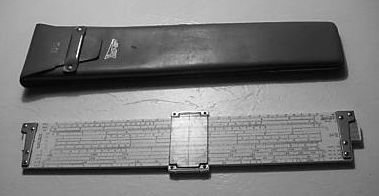 When I went to school in 1962 to get a BS in Electrical Engineering I was
surprised that I was required to take a course in computer programming. I
didn't see any connection between engineering and computers. The better
schools were just beginning to see the potential. This one required a one
hour per week course for one term - that was it, one course in the entire
four years. It was 1975 or so before I ever met anybody who had majored
in Computer Science.
When I went to school in 1962 to get a BS in Electrical Engineering I was
surprised that I was required to take a course in computer programming. I
didn't see any connection between engineering and computers. The better
schools were just beginning to see the potential. This one required a one
hour per week course for one term - that was it, one course in the entire
four years. It was 1975 or so before I ever met anybody who had majored
in Computer Science.
The calculating tool of the early 1960s was the slide rule. We all walked
around with them hanging from our belts. There were no electronic
calculators, few calculators small enough to carry, certainly none that
ran on batteries. Few people had ever seen a calculator that could
multiply and those that could divide would be introduced in the next few
years.
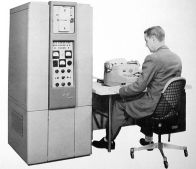
The Bendix G15
This one used vacuum tubes - mostly 12AX7 tubes I think.
Sometimes a job it was doing would take quite a few hours. We couldn't
wait for it to finish, so we would end the program with an instruction
that turned off the computer. It used a lot of electricity, so Bendix had
built in an instruction to turn it off (a feature that disappeared for the
next 20 years). The next morning the computer's typed output would be
waiting for us.
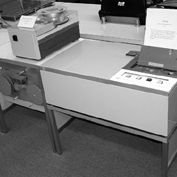
The LGP30 and LGP21
These were made by General Precision Corporation in the 1950s and 1960s.
I never saw an LGP30, just pictures. It was another vacuum tube
computer. But the LGP21 was a real treat. It was about the size of an
office desk including its Flexowriter (an IBM electric typewriter with a
paper tape reader and punch). It had 4096 words of memory,
32 bits each. That was it - the memory and the Flexowriter and a
processor which could execute 16 different instructions. There was no
disk drive as we know it. However, the memory and the registers were
actually on a magnetic disk. It was a 10 inch diameter 1/2 inch thick
piece of steel with 32
fixed heads riding on top. You could open the cover and watch it spin.
Each head accessed a track containing 128 words of "memory".
A 33rd track had several sets of heads around it each spaced to cycle a
single 32 bit word from a write head to the disk and then to a read head
positioned 32 bit positions later around the disk. These were the
registers. All the logic was serial - natural considering everything was
continuously moving round and round. The circuitry was on a handful of
cards about a foot square each full of transistors. It used 20 volt
resistor-transistor logic. Its hexadecimal numbers used the symbols
0123456789FGJKQW - don't ask why?
I had so much fun with that computer!
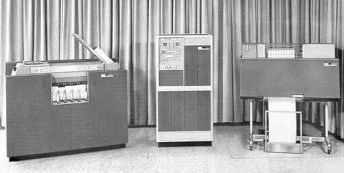
The IBM 1401
The first computer I ever programmed - 16000 characters of memory, no
disk drive of any kind. Cards went in, cards and printing came out.
We used FORTRAN.
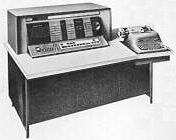
The IBM 1620
Another decimal computer - actually more decimal than the 1401 was. It
used decimal addressing too - had 20,000 digits of memory. It was so
simple to use that we programmed a lot in actual machine language. It
also did FORTRAN and pretty soon FORTRAN II. If you remember the 1620,
you remember this: 160001000000
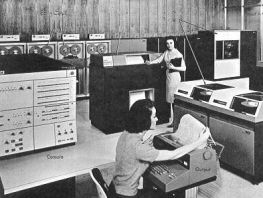
The Mainframe
It was the middle 1960s when the IBM 360s came out (not to mention the RCA
Spectra). IBM and RCA were racing to replace transistors with integrated
circuits. RCA was about to get there first when IBM played a trick on
them. IBM came up with a way of building the guts of components
(transistors, diodes, resistors) without their cases, and hooking a bunch
of them together to make a circuit, and then putting one case around the group.
They called it SLT (Solid Logic Technology) and passed it off as
integrated circuits. It worked - try to buy an RCA computer now.
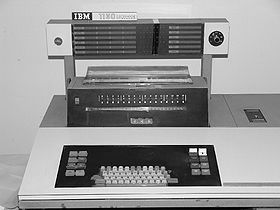
The Minicomputer
64 Kbytes was the magic amount of memory for about 10 years.
These machines costing about $50,000 at first and as little as $10,000
near the end, seemed like the answer to all our problems. Memory was
getting so fast - less than 1 microsecond cycle time!
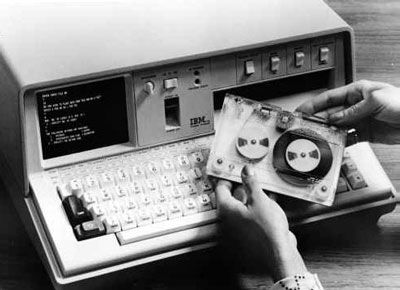
The Portable Computer
IBM was ahead of the rest when they brought out the IBM 5100 portable
computer in 1975. It was a powerful 16 bit minicomputer with keyboard and
monitor built in. All of personal computer history would be different if
this computer had been a little more ordinary. Even though IBM
was manufacturing eight inch floppy drives, they configured this computer
with a cassette drive. The first simple disk operating system had been
created by IBM ten years earlier but this machine could only be programmed
in APL or BASIC, both languages supplied in ROM with very poor access to
mass storage. Nobody bought these computers.
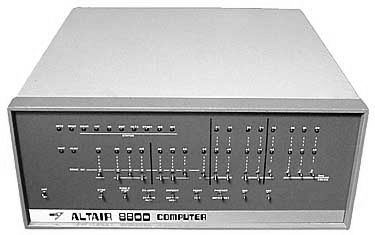
The Microcomputer
The first popular microcomputer was
Altair.
It was a kit. Soon we had
IMSAI,
Cromemco,
Compupro,
Northstar, and others. Radio
shack brought us the TRS-80. Pretty soon Commodore was the big thing.
There was some popular software we thought would never be replaced:
| |
- operating system - CP/M
- programming language - BASIC
- word processor - Word Star
- spreadsheet program - Visicalc
- data base program - dBASE
|
Commodore had an operating system named
GEOS, a lot like Windows but much nicer. It included dial-up access to
their network called America Online.
After a while it looked like Apple was the winner. While most microcomputers looked like
they belonged in a laboratory, the Apple fit well in a home or office.
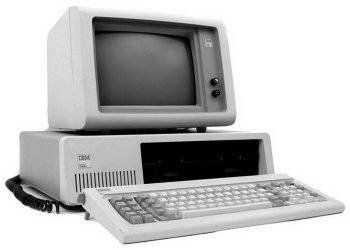
The Personal Computer
Turn it around and look at the back and you'll see the model number is
5150. It seems like six years later the IBM 5100 group tried again. The
timing and announcement made it clear that IBM intended to enter the
microcomputer market. Howerver, as was their style, they did everything
differently from everybody else, starting by dropping the microcomputer
name and coining the name Personal Computer. We all enjoyed criticizing
its "stupid" design choices and we all bought it.




 When I went to school in 1962 to get a BS in Electrical Engineering I was
surprised that I was required to take a course in computer programming. I
didn't see any connection between engineering and computers. The better
schools were just beginning to see the potential. This one required a one
hour per week course for one term - that was it, one course in the entire
four years. It was 1975 or so before I ever met anybody who had majored
in Computer Science.
When I went to school in 1962 to get a BS in Electrical Engineering I was
surprised that I was required to take a course in computer programming. I
didn't see any connection between engineering and computers. The better
schools were just beginning to see the potential. This one required a one
hour per week course for one term - that was it, one course in the entire
four years. It was 1975 or so before I ever met anybody who had majored
in Computer Science.








